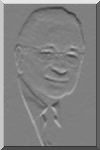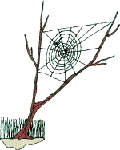

This information about the ministry of Herbert W. Armstrong is part of the
Field
Guide profile Herbert W. Armstrong -
which is part of a larger
profile of the Worldwide Church of God under founder Herbert Armstrong.
 The Myth
The Myth
During his lifetime, Herbert W. Armstrong (HWA) was many things to many people.
In the minds of his most loyal supporters, he was a Great Man of God. Other supporters and associates may have been a bit more circumspect and merely viewed him as a good Biblical teacher and religious broadcaster. Still others may have viewed him as just a forceful and effective leader.
To some of his detractors, he was a misguided zealot. . To others he was a megalomaniac. And to still others he was a false prophet and/or a false teacher.
However, those who held the strongest positive opinions about the man's role may
well have been those who had no direct contact with him. Viewers of fictional TV
shows such as soap operas can develop the illusion that they "really know" an actor
or actress. In the same way, members of religious groups can have the illusion that
they really know a man whom they have only heard on radio, seen on TV, read impersonal
mass-
The evidence is extensive that Herbert Armstrong did, indeed, elicit just that sort of response from many of his listeners and supporters ... he wrote and spoke in such a way that seems to have left many in his audience feeling that he was sharing his most intimate thoughts and feelings with them. And the result was a fierce loyalty to the man to whom they looked as perhaps at least a "father figure" and at most the Mouthpiece of God on Earth.
During the last two decades of his life, Ambassador College and the Worldwide Church of God went through considerable turmoil. A significant number of members and ministers, as well as employees at WCG Headquarters, became disappointed by many of HWA's actions and policies. And they became disillusioned by documented negative information about Armstrong and some of his associates.
But because the WCG was a totally authoritarian organization, it was possible for most of this unrest to be ended quickly—by removing any and all dissenters, and ordering those who were unaware of the issues to avoid any and all information which such dissenters might attempt to communicate. Within such a closed system, a Myth can be created and sustained.
Such was the Myth of Herbert Armstrong. Rather than just the media spokesperson for a religious group, or the chief executive officer of that group, he was viewed by many as most or all of the following:
1. God's Apostle
2. A latter-
3. A latter-
4. The Restorer of Lost Truth that had been hidden since the first century
5. The human Head of the One and Only True Church of God on Earth today
6. The most righteous and holy person alive, the closest to God of any man in his generation
7. The wisest and most spiritually astute man alive
As all of these things and more, he was viewed as the one who could place in positions of authority all men under him within the church organization. All of his doctrinal opinions and teachings were totally binding on everyone in his organization. He could command total loyalty to his every policy, and remove people at will from both employment with the organization... and from the One and Only True Church.
And, as with many men who are "bigger than life" when alive, his death in 1986 only
increased the power of his Myth rather than diminished it in any way. Many members
who joined the WCG after his death, and who thus only came to know him at all through
his writings and his reputation among "old-
When the WCG itself began crumbling in the early 1990s, as a result of the doctrinal innovations of HWA's successor Joseph Tkach, the Myth remained as a rallying point for those who were being shaken by the changes they saw to the system that had been created by HWA. Group after group left the mother organization and formed new, smaller Church of God church denominations which had, as one of their chief purposes, to hold on to the legacy of Herbert Armstrong. And thus they quickly announced their intent to either perpetuate or restore their own version of the Myth.
Within those groups which have imitated the repressive system of control of negative information, the Myth has been able to thrive.
However, the advent of the Internet has made such repression more difficult than it ever was in the past. At one time in the WCG, individuals could be disfellowshipped from the group just for studying or passing on "dissident literature."
But the anonymity of the Internet, and the ability of people with questions about "the past" to just quietly seek information within the privacy of their own home on their computer screen, has opened up a whole new distribution method for answers to troubling questions.
Thus this website, and many more like it.

Researching the Myth:
Online Documentation
The Field Guide webpage Research Resources on the Worldwide Church of God and Herbert Armstrong provides extensive documentation about the reality behind the Myth of Herbert Armstrong.
For the naïve member of one of the off-
To the merely curious outsider, it may be utterly fascinating.
And to the person who is really looking for “The Plain Truth,” it should be highly illuminating.
Return to:
Herbert W. Armstrong -
Unless otherwise noted, all original material on this Field Guide website
is © 2001-
Careful effort has been made to give credit as clearly as possible to any specific material quoted or ideas extensively adapted from any one resource. Corrections and clarifications regarding citations for any source material are welcome, and will be promptly added to any sections which are found to be inadequately documented as to source.
Return to Top of Page and the Navigation Bar

Herbert W Armstrong:
The Myth
